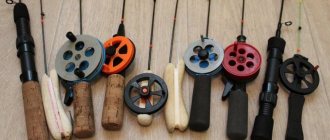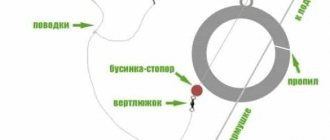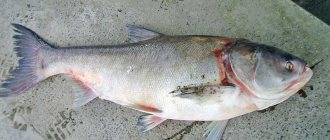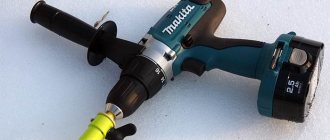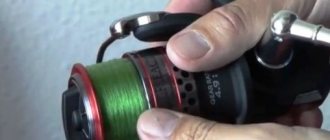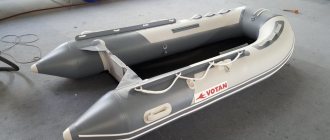Purpose and principle of operation of the ice auger
The main purpose of a classic ice drill is to drill cylindrical holes in ice to a depth of up to 1 meter, which distinguishes this tool from an ice pick.
During operation, the noise emitted by this device is at a fairly low level, which is a significant argument when fishing.
The device and principle of drilling ice is similar to the rotators used in construction.
For this reason, some craftsmen use an ice drill when installing poles, which leads to damage and complete unusability of the knives.
There are models with replaceable augers, which allows, when installing the appropriate equipment, to drill both ice and soil.
The only difference is that when drilling ice, the knives do not cut off its layers, but break off pieces ranging in size from grains of sand to heavy stones.
Introduction
Every ice fishing enthusiast needs a mechanism for creating holes in the ice shell of a reservoir. And if in the first ice you can go winter fishing with an ice pick, then the rest of the closed water season has to be spent in tandem with an ice screw.
However, a universal drilling tool has not existed for a long time. Even in the Soviet years, fishermen wanted to have a real assistant, so many store models were modernized, and high-quality homemade designs also appeared.
Today, a newbie winter driver may simply get confused when choosing his first ice auger. And in order not to make a mistake when purchasing, you need to get acquainted with the varieties of these fishing tools. Let's consider the criteria for selecting a manual ice auger.
Fans of winter fishing, when preparing for the ice fishing season, have to purchase a lot of different equipment and accessories. One of the most important items in an ice fisherman's arsenal is an ice auger.
If during the first ice or during the period of last ice you can go fishing with an ice pick, then when the ice thickness is 10 cm or more, you can quickly make holes in the ice shell of a reservoir only with the help of a drilling tool.
Today, anglers can use not only traditional manual models, but also electric and gasoline devices. However, experienced winter travelers often choose titanium ice screws for ice fishing. They have a number of important advantages.
Beginners who love winter fishing should know what parameters they need to pay attention to when choosing a titanium product.
Types of ice drill knives
The type of knives you choose will largely depend on the thickness of the ice. If drilling a dozen holes in the first ice is as easy as shelling pears, then drilling a meter thick ice will be a tedious task. What’s funny is that the fish will not stand still and constantly move around the reservoir and drilling deep holes will definitely not give anyone pleasure.
A competent choice of knives will allow you to quickly drill even thick ice, but for this you need to take into account factors such as its density, humidity and layering. Today, manufacturers produce the following types of blades:
- Universal;
- Spherical;
- Oval and stepped.
Let's look at each type of knives separately and figure out which ones are better.
Spherical ice drill knives
An ideal option, adapted to a variety of ice, regardless of its density, structure and number of layers. But, this type of blade has one significant drawback - they are difficult to sharpen. To properly sharpen blades at the right angle, you need to know or be a professional in this matter.
Device and characteristics
• Handles. In a manual ice auger, they are placed on opposite sides of the central axis, or the upper handle is located strictly on this axis, forming a brace. Drilling is done with both hands, which allows you to evenly distribute the load.
• Auger – the spiral part of the tool, located below the handles, is designed to remove ice chips from the hole, determines the direction of rotation of the ice auger. It is connected to the brace with a connecting unit, which can be telescopic or removable. It is a rod with a welded spiral in the form of a metal strip.
• The cutting part is directly responsible for cutting into the ice. In most cases, it is a holder with two straight or rounded knives, or a monolithic cutting head. The shape determines the effectiveness of drilling holes in ice with specific characteristics. This is also affected by the angle of attack and tilt of the knives.
For electric and gasoline models, the handles are located directly on the frame with a drive, and are designed to fix the tool in a stationary position, preventing rotation opposite to the direction of drilling.
Material
In the production of ice tools, mainly cold rolled sheet steel or hardened steel with a high-quality coating is used.
There are titanium options, but along with the high strength and lightness of this material, which, due to the formation of an oxide film, is protected from corrosion, there are also disadvantages.
Among them are high cost, loud ringing noise when drilling, freezing of large amounts of ice in severe frost.
Iron is used less often because it is heavy.
The handles are covered with a material that should not crack upon impact.
Here the leader is hard rubber, which has a tactile sensation reminiscent of microporous rubber.
As for tool knives, they are made mainly from stainless alloy steel or tool steel.
The main dimensions of an ice auger are its length and the diameter of the auger.
The latter determines the diameter of the hole, and the first determines the drilling depth.
As for weight, on average it is about 2.5 - 3.5 kg.
The length in working position, as a rule, varies between 1.5 - 1.9 m.
This parameter can be increased by using a special extension, which is a rod 200 - 600 mm long, which is installed between the auger and the handles.
Auger sizes
The diameter of the auger is selected depending on the size of the fish:
- 90 – 100 mm – for sport fishing;
- 110 - 130 mm - for fishing with a balancer or jig;
- 150 mm – for fishing with girders;
- 180 – 250 mm – for catching large fish.
Basic parameters of the ice auger
The numerous assortment of ice drills that are present on the Russian fishing market today should be divided into several groups.
In addition, classification must be made according to several parameters.
- The price factor often has the main influence on the purchase of the first ice auger. A fisherman, seeing price tags for various products, intuitively fixes his gaze on the lower or middle range. I think that it is better for a novice subglacier to start getting acquainted with drills using the example of available Russian products. Moreover, the quality of our instruments has improved significantly in recent years.
- The diameter of the screw is also an important parameter of the drilling tool. Today you can purchase models that instantly make holes with a diameter of 90-100 mm, or give preference to mechanisms with a large auger diameter (180-200 mm). A beginner in ice fishing should choose an auger size based on the type of fish he plans to catch. To hunt for perch, roach and medium-sized pike, it is enough to make the narrowest holes. But for fishing for bream, bream, large pike perch and pike, you should stay at the maximum auger size.
- The connecting unit for ice screws also differs. For example, the Leningrad tool, after being brought into working position, is fixed with a plate and a wing nut. After the test I had to immediately replace both the plate and the nut. The thickness of the plate is too small, so it bends, and the joint of the two parts of the ice drill begins to play. I also installed a larger nut, since my hand strength was not enough to securely fasten the tool. A similar unit design is available in the Swedish Mora Expert, but the locking plate does not bend even when drilling through thick ice. In addition, the nut is carefully coated with a polymer that prevents fingers from freezing at low temperatures.
- The direction of rotation of the ice auger becomes a stumbling block for some anglers. If for a beginner it is not very important which direction the tool needs to be rotated, then for an experienced fisherman, accustomed to a certain direction, it is very difficult, and sometimes impossible, to relearn. Not so long ago, the vast majority of domestic models had left-hand rotation, that is, the working handle had to be turned counterclockwise. Imported analogues usually work in the opposite direction. In this regard, when purchasing, it is important to pay special attention to this point.
How to sharpen a cutting edge
It is no secret that any cutting object, no matter how good the material it is made from, becomes dull over time. Drill knives produced in our country are made of fairly soft steel. Therefore, when actively using ice augers, they have to be adjusted several times a season. Ideally, you need to have several sets and, after the end of the winter season, have them all professionally sharpened. If this is not possible, then you will have to sharpen it yourself.
When adjusting the edge in this way, you need to be extremely careful. The blade can easily injure your hands. In addition, sharpening can only be done from the inside, where the blades have a sharpening angle. Attempts to sharpen them on the flat outer side, where the recesses for countersunk screws are made, will only lead to complete damage to the blades.
The quality of sharpening of the cutting edge is checked very simply: you need to try to cut a sheet of newsprint by weight. A well-sharpened blade will do this without difficulty. If the paper tears, the editing procedure will have to be repeated.
You just need to heat the knives very high so that the paint, rust and all the slag burns out. Then you need to slowly lower it into the water. Do this several times.
Types of ice drills and their prices
• Manual – rotated by hand.
READ MORE: What is the difference between calm lining and euro lining
There are one-handed versions, where one of the handles is located on the same axis with the auger, and two-handed ones - with handles spaced on opposite sides of the axis.
The cost starts at 1500 rubles.
• Gasoline – driven by an internal combustion engine.
Among the advantages are the ability to drill large-diameter holes and operability at low temperatures.
The disadvantages of a motorized ice drill include noise, the presence of exhaust gases, and the need for fuel.
The motor of this fishing tool has handles attached on both sides, which act as a frame, and the auger is attached to the gearbox shaft.
The cost of good models complete with an auger ranges from 25 to 50 thousand rubles.
• Electric.
The auger is rotated by an electric motor powered by a battery.
Among the advantages of an electric ice drill are ease of operation and low noise level.
Compared to the previous option they have a low cost.
Most cordless ice augers are equipped with electrical cables for recharging the battery from a car cigarette lighter.
High-quality models will cost the buyer 18–30 thousand rubles.
Electric models include a screw mounted with a special adapter in a screwdriver chuck.
Some manual options are initially suitable for use with a power tool, gasoline or electric motor.
A screwdriver for an ice drill must have a torque of 80 N/m and have a battery with a capacity of more than 2.5 Ah, where the voltage is at least 18 V.
• Screw – the most common option.
Structurally, it is a rod on which knives are attached in the lower part; there is a spiral metal tape around the entire length.
Available in diameters from 70 to 250 mm.
• Ice drill “cylinder” – used extremely rarely.
Another name is “cutter”, obtained due to the corresponding shape of the cutting edge.
In operation, a circular ice drill cuts a circular groove through the entire thickness of the ice.
The resulting ice cylinder is simply pushed under the ice.
• Ice drill “spoon” – the cutting part is made in the form of a tablespoon with a pointed edge.
This design is considered obsolete and is used extremely rarely, since an unreasonably large amount of effort is spent on the work.
Rotation is performed in any direction.
For ease of transportation of the ice drill, its length is expected to be reduced.
• Telescopic models – broken in half due to a special connection.
The length of the tool is reduced by almost half, depending on the length of the auger.
• Options with a removable handle, where the handle is removed accordingly.
• Models for dry ice – equipped with flat blades, which are ineffective on wet ice due to their frequent jamming.
• Models for wet ice – equipped mainly with spherical knives.
Such ice screws are often called universal, as they cope well with all types of ice.
Products equipped with replaceable knives allow you to adjust the angle of attack and tilt using washers and pads to achieve better performance.
On the Russian market, the most popular are ice screws from the following manufacturers, which can be found in almost any fishing store:
- Mora – Sweden;
- Rapala – Finland;
- Asseri – Finland;
- Tonar – Russia.
Less common are Alligator, Heinola and Rextor, and domestic manufacturers include Nero, Sotka Kazantseva, Legion Ice Drills, Ivanovskie, Leningradskie, Sovetskie drills and Ermakov Ice Drills.
Review of ice screws for winter fishing
Let's look at the most well-known tool manufacturers, as well as individual models, which will allow you to navigate well in a wide range of products.
Ice screws Mora
The manufacturer is based in Sweden and is the most popular among other foreign suppliers of this tool. The design of most models uses spherical blades that do an excellent job of cutting ice of any composition. Let's highlight some of them:
- Expert Pro - resembles the classic model, but has a number of improvements. Screw diameter – 110, 130, 150 and 200 mm to choose from. This version of the ice drill will be effective in any conditions, will not fail in difficult situations and will last for many years. The handle is foldable with a retractable system that allows you to increase the height. The auger can be used with an electric screwdriver.
Ice Arctic – extended auger for thick ice. In addition, there is the possibility of installing an additional extension, which ensures successful drilling even with ice thickness of 2 meters. Diameter 110, 130 and 150 mm to choose from.
Ice Micro is a small tool that can be easily used even by women and children. The handle is telescopic and has 4 positions, so everyone can set the height to their height. Available in all popular screw diameters.
Nova System is the leader in the rating of ice drills from this manufacturer, available in diameters of 110, 130 and 160 mm. Any variation requires the installation of an additional extension 30 cm long. The model comes with improved spherical-type knives, which have a complex bend and a corresponding sharpening angle of the edges. The cutting head is made from an incredibly durable composite type material. Additionally, there is a universal, high-speed and cutting head for gasoline or electric drive. The handle folds with a TwinLock connection and is covered with reflective material for easy identification in the dark.
Ice screws Rapala
Unlike the previous manufacturer, removable cutting heads are used, not knives. The advantage is increased productivity, but the disadvantage is high cost. Self-sharpening will be impossible for most fishermen. The diameter of the screws varies between 110-180 mm. For transportation, the ice auger is folded in half or bent only in the handle area.
Ice screws Heinola
In the rating of ice drills, this Finnish manufacturer stands out for the presence of non-replaceable blades on the tool. Thanks to the unique design, drilling holes requires virtually no physical effort. The price is comparable to models from Mora. Let's look at two popular series of these ice screws:
- Easy Run – models with removable spherical knives, a telescopic handle, fixed in four positions. Available in all popular diameters. The EasyRunLong model has an extended handle and auger, which allows you to drill through ice up to 1.5 meters thick.
SpeedRun models offer incredibly high performance, making them the fastest on the market. This effect is achieved thanks to the special design of the blades, the edges of which are coated with stainless welding wire.
Ice drill Leningradsky
The production was launched back in the days of the USSR; accordingly, the model is distinguished by its simplicity and the ability to be serviced at home. Straight knives are used, which dull quickly enough - fortunately, they can be sharpened using the appropriate tool. The diameter of the auger is 130 mm, the maximum depth of water is 80 cm. The handles are plastic and fit comfortably in the hand, but can crack in severe frost.
The recommendations presented will help you understand how to choose an ice screw for winter fishing, which manufacturers and models to pay attention to. First of all, the tool must meet the personal requirements of the fisherman and the conditions of use
When choosing, special attention should be paid to the type of knives used, the length and diameter of the auger, the material of manufacture and the folding method. Also read our article “How to sharpen ice drill knives.”
What you need to know about ice screws?
Flat
They are used mainly on domestic products.
Among the advantages are low cost, compactness, ease of replacement and the ability to sharpen at home.
Disadvantages: frequent chipping of corners.
Spherical
They are used in most cases on imported ice screws.
The advantages include quieter operation, smoother running, efficient drilling of wet ice and reaming out old holes.
Flat knives, in turn, according to the configuration of the cutting edge, are divided into:
- Straight – the edge is made in the form of a straight line;
- Rounded - the edge has a smooth rounding along its entire length;
- Serrated – straight edge with slots. The protruding parts form teeth.
- Stepped - steps made of two or three straight edges.
Instead of knives, some ice augers, particularly those from Rapala, use a removable spherical cutting head.
READ MORE: Warm and cool colors in the interior, rules for combining shades and tones in the bedroom, living room and other rooms
• Electric.
When choosing an ice drill, you should take into account its following characteristics:
- • Rod length (to handle) – determines the maximum thickness of ice that can be drilled. This figure can be increased by using extension cords.
- • Auger diameter – completely determines the diameter of drilling holes. Depends on the size of the fish for which the hole is drilled. The most common diameters are 110 – 130 mm.
- • Noise level during drilling. When fishing, sometimes this indicator is decisive, since excessive noise can simply scare away all the fish. Among hand-held ice augers, titanium models are considered the noisiest, producing a characteristic ringing sound. In addition, improperly sharpened knives can also make noise. Among all ice drills, the noisiest ones are gasoline models.
- • Availability of spare knives. When choosing an ice drill model, you need to make sure that the knives for it are on sale, and you won’t have to spend weeks searching for them. The fact is that knives are the first thing to fail. They get dull and break.
In addition, variants of a certain configuration are better suited to certain ice, which means that when fishing you must have at least one set of replacement knives with you.
- • Weight. Lightweight models are comfortable to carry, but their low weight makes drilling more difficult.
It should be noted that you can easily drill the ground with an ice drill if you install an auger appropriate for this task on it.
In order to expand the functionality of the device in this way, you should check in advance the availability of similar screws on sale for a specific product model.
Double-bladed ice screws are the most widely used.
Three knives are installed, as a rule, only on models whose auger is made of titanium, providing an easier move.
The other side of the coin is that three knives become clogged with ice crumbs faster.
The angle of attack is one of the most important characteristics of knives. The shallow angle is great for working on sticky wet ice.
Drilling takes longer, but is much easier.
Dry hard ice lends itself better to drilling with cutting elements with a larger angle.
The number of drilling revolutions in this case will be less, but physical effort will have to be made.
Consequently, the angle of attack for a layer of ice formed by severe frosts in a snowless winter increases slightly, and for a loose layer of ice in spring it decreases.
Alternatively, you can experimentally find the average angle, but there can be no universal solutions to “ice issues”.
In field conditions, when you need to drill one to three holes, it is enough to have a spare set of knives in case the main one breaks.
If you plan to drill a large number of holes, it is advisable to have a set of different types of blades with you, and then install the ones suitable for the operating conditions locally.
Ice drills can be used for drilling shallow holes in frozen ground, but one must understand that during such work the knives quickly become dull.
In general, the suitability of this tool for such work is questionable, since the main purpose is to break off pieces of ice that are denser than the soil.
For excavation work, specially designed drills or rotors are used.
Proper operation of ice drills significantly extends their service life.
• After each fishing, all elements of the product should be thoroughly wiped of water, and the knives should be coated with a thin layer of machine oil.
• You can protect your knives from becoming dull during transportation by using a special cover.
• When drilling, you cannot hit the ice with an ice auger, as this leads to breakage and dulling of the knives.
• To warm knives, it is unacceptable to use an open flame, since fire changes the properties of the metal, which leads to rapid wear of the cutting elements.
• Sand contaminating the ice can damage both the knives themselves and the coating of the ice auger. To avoid the spread of corrosion to exposed areas of metal, all scratches after fishing are covered with paint.
• Using an ice auger to drill holes in the ground may cause it to break. For these purposes, products that will no longer be used for their intended purpose are better suited.
• A wet auger should not be placed in snow. It is preferable to leave it drilled into the ice to a depth of 10 cm. Otherwise, ice build-ups will form on the auger.
• Ice-covered knives should never be cleared of ice by blows, especially using metal objects such as a hammer. This is a direct way to break them.
• Drill elbows and all threaded connections must be lubricated periodically.
Before long-term storage, all elements of the ice drill are lubricated with machine oil, after which special protective caps are put on the knives.
Anglers underestimate many details of an ice drill when making their first choice. Most people focus on the shape of knives, missing out on other parameters of the tool.
What knives are preferable for drilling holes?
- The cutting part of domestic and imported ice drills has significant differences. It is knives that primarily attract the attention of fishermen. All domestic models are equipped with flat trapezoidal structures. They cope well with loose ice. But in frosty weather the knives begin to slip, then the advantage of imported products becomes obvious. It is dangerous and useless to drill old holes that have frozen over with a domestic ice drill. But sharpening flat knives can be done not only by specialists, but also by the fisherman himself.
- Some imported ice screws are equipped with spherical knives. They work great both during a thaw and in severe frost. For spherical knives, it will not be difficult to update an old hole without the usual jamming. However, when it comes time to sharpen, anglers may face serious problems. For this reason, it can be easier to purchase a set of new cutting elements than to revive old samples.
READ MORE: Thomas vacuum cleaner washing machines for wet cleaning models with aquafilter repair tips
Important: In addition to the diameter of the screw, it is necessary to inspect the quality of welding when purchasing.
- In domestic models, the screw is welded to the axis of rotation in separate places (spot welding). The result of such a connection is an insufficiently rigid structure. In addition, due to this manufacturing technology, our tool creates a lot of noise during the drilling process. And if fishing takes place in shallow waters, you will have to wait a long time for the frightened prey to arrive. Even when hunting for pike at a depth of about 5 m, a negative attitude of fish to the sound of a working tool is observed.
- Imported samples compare favorably in this regard. The Swedish ice drill Mora Eriksson is also made using spot welding technology, but the quality of the connection is much higher. Finnish Rapala models are distinguished by a fully welded auger. Thanks to these little details, Scandinavian ice drills make less noise and do not frighten fish too much when drilling.
On the domestic market you can find a whole range of titanium ice drills from different manufacturers.
Let's look at a few of the most popular brands.
The domestic manufacturer from the banks of the Neva, FGUL Leningrad Northern Plant, has deservedly gained fame among domestic fishermen. Ice screws from this company are distinguished by excellent quality and reliability.
Titanium models were no exception. The St. Petersburg assortment includes tools with different auger diameters, with a standard and extended handle, with 2 and 3 knives.
Every ice fishing enthusiast will find the most suitable option for himself. For example, the standard model LSZ "Leningradsky" is available in 6 versions:
- P1004 has 4 turns of a spiral, 2 knives, an auger with a diameter of 100 mm and a cost of 5,690 rubles;
- P1005 differs from the modification described above in that it has 5 turns on the auger and costs 5,980 rubles;
- P is the designation of a standard titanium ice drill with 2 knives and an auger thickness of 130 mm - 5840 rubles;
- P3 differs from the standard version (P) by 3 knives and a price of 6190 rubles;
- P150 belongs to ice screws with a wide auger with a diameter of 150 mm, is equipped with two knives and costs 6,290 rubles;
- The P3150 differs from the P150 in the presence of 3 knives, which affects the price of 6,690 rubles.
All of these ice drills will help cope with ice up to 1 m thick. If desired, anglers can choose models adapted for drilling with a screwdriver, as well as modifications with a long handle or additional turns on the auger.
Barnaul ice screws also have high performance characteristics. Titanium models are extremely durable and lightweight. The company's assortment includes fishing tools for different tastes.
- Among the sports products we can highlight the TLR-100SD-2N model. The weight of the ice drill is only 1.8 kg, and the diameter of the holes will be 100 mm. The model is equipped with traditionally sharp 2 knives. The cost of such a tool is 8250 rubles.
- The standard ice auger is the TLR-130D-2N product. It is equipped with a screw with a diameter of 130 mm, and the model weighs 1.6 kg. This modification retails for 7,540 rubles.
- TLR-130D-3N differs from TLR-130D-2N by the presence of 3 knives. At the same time, the weight of the model increases to 1.7 kg, and the retail price is 7,930 rubles.
- The TLR-130D-3NTSh ice drill has a telescopic auger that allows you to drill very thick ice up to 1900 mm deep. The weight of the product is 2.35 kg, and you can buy such a tool for 9940 rubles.
- The TLR-150SD-2N model is in demand among fishermen. The screw diameter is 150 mm, the product weight reaches 1.65 kg. You can buy an ice screw for 8190 rubles.
Drill device: what to pay attention to
A typical hand-held ice auger consists of three parts:
- head with knives;
- auger for throwing sludge out of the hole;
- lever.
There are other design solutions without a screw: “spoon”, “glass” or ring. But they are less convenient and are rarely used today.
When choosing an ice drill, you should first pay attention to the following points:
- Shape and quality of knives.
- Reliability of connecting units (axial locks).
- Resistance of anti-corrosion coating.
- Ice auger weight.
- Screw diameter and length.
It makes sense to take a closer look at how the auger ribbon is welded to the rod. Often it is attached pointwise, and with intensive use the tape can come off. It is better if it is welded along the entire length. In addition, an ice auger with a solid auger makes less noise.
Such nuances as a telescopic handle or a replaceable cutting head, although not fundamentally important, can have a certain significance. For example, a retractable handle will allow you to adjust the drill to the angler’s height or drill to a greater depth even with a short auger (in several steps). And changing the head with a slight movement of the hand in the cold is much easier than unscrewing and installing new knives.
On a note! An ice auger should not be confused with an ice axe. An ice ax is a piece of climbing equipment similar to a pickaxe. He cuts the ice, not drills it. An ice ax for fishing can only be called a half-forgotten “grandfather’s” ice pick.
By the way, how to make an ice pick with your own hands is written here.


